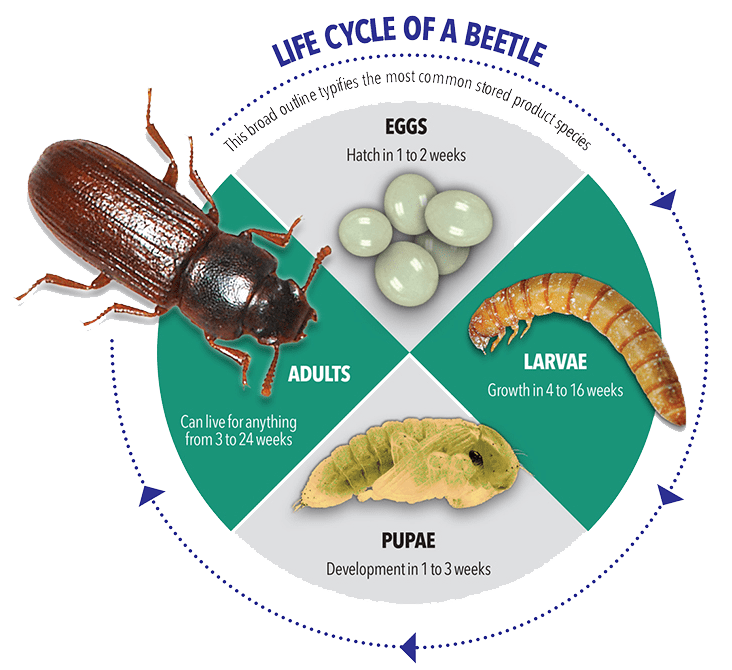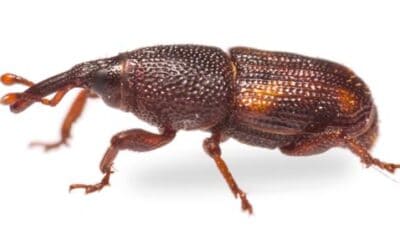
Stored Product Insects or ( SPI ) for short The main reason we control SPIs is the incredible damage and contamination they cause to foodstuffs, raw materials and finished products. SPIs not only eat these products, they breed in them and can spread quickly, contaminating a huge amount of product which is then unfit for human consumption. Contamination of foodstuffs is such a huge concern that there is an entire branch of forensic entomology dedicated to studying it. You can identify if you have a problem by using some of our bullet points below.
 Discoloration of food products, such as flour
Discoloration of food products, such as flour
 Damage to raw materials, tainting
Damage to raw materials, tainting
 Small holes in nuts or grains
Small holes in nuts or grains
 Live or dead insects, larvae, pupae or silken webbing
Live or dead insects, larvae, pupae or silken webbing
 Track marks in powder, flour or grain
Track marks in powder, flour or grain
The two most common pest in this category are the Grain Weevil and the Rice Weevil. Weevils have long, pointed “snouts” which they use for boring into whole grains, hard processed cereals such as pasta, and timber.

STORED PRODUCT INSECTS - WEEVILS
The Rice Weevil ( Sitophilus Oryzae )
The adults are usually between 3 and 4.6 mm long, with a long snout. The body color appears to be brown/black, but on close examination, four orange/red spots are arranged in a cross on the wing covers. It is easily confused with the similar looking grain weevil. The grain weevil is typically somewhat larger than the rice weevil, but sometimes this is not always the case.
Adult rice weevils are able to fly, and can live for up to two years. Females lay 2-6 eggs per day and up to 300 over their lifetime. The female uses strong mandibles to chew a hole into a grain kernel after which she deposits a single egg within the hole, sealing it with secretions from her ovipositor. The larva develops within the grain, hollowing it out while feeding. It then pupates within the grain kernel and emerges 2–4 days after eclosion.
Control Methods
The source of the infestation should be traced. Any affected foods should be discarded. The area should then be thoroughly cleaned, and a residual insecticide should be used by a pest technician such as Environmental Pest Solutions.
Give us a call to sort any stored product infestations, use our contacts page.
The Grain Weevil ( Sitophilus Granarius )
is an insect that feeds on cereal grains, and is a common pest in many places. It can cause significant damage to harvested stored grains and may drastically decrease crop yields. The females lay many eggs and the larvae eat the inside of the grain kernels.
Adult grain weevils are about 3–5 mm (0.12–0.20 in) long with elongated snouts and chewing mouth parts. Depending on the grain kernels, the size of the weevil varies. In small grains, such as millet or grain sorghum, they are small in size, but are larger in maize (corn). The adults are a reddish-brown color and lack distinguishing marks. Adult grain weevils are not capable of flight. Larvae are legless, humpbacked, and are white with a tan head. Weevils in the pupal stage have snouts like the adults.
Control Methods
The source of the infestation should be traced. Any affected foods should be discarded. The area should then be thoroughly cleaned, and a residual insecticide should be used by a pest technician such as Environmental Pest Solutions.
Whether in a commercial or domestic setting, Environmental Pest Solutions can assist you in completely ridding your property of any type of weevil. Our expert team will work quickly and efficiently to remove the problem with minimal disruption.
